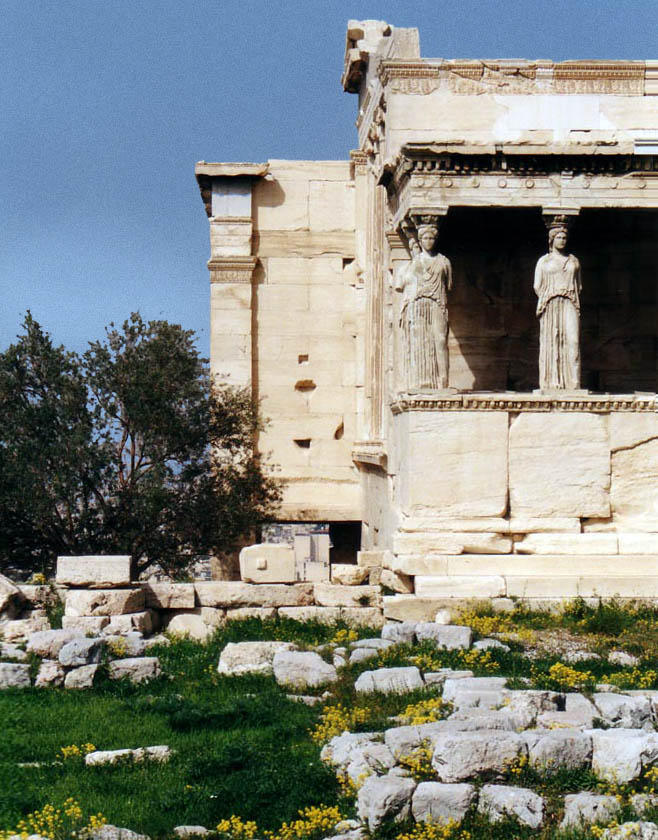You can download my Ph.D. thesis for free as a pdf document.
FULL THESIS TEXT ONLY PDF
Contact Alexandra: This email address is being protected from spambots. You need JavaScript enabled to view it.
ABSTRACT (from the thesis): "A Diachronic Examination of the Erechtheion and Its Reception” examines the social life of the Ionic temple on the Athenian Akropolis, which was built in the late 5th century B.C. to house Athens’ most sacred cults and relics. Using a contextualized diachronic approach, this study examines both the changes to the Erechtheion between its construction and the middle of the 19th century A.D., as well as the impact the temple had on the architecture and art of these successive periods.
"A Diachronic Examination of the Erechtheion and Its Reception” examines the social life of the Ionic temple on the Athenian Akropolis, which was built in the late 5th century B.C. to house Athens’ most sacred cults and relics. Using a contextualized diachronic approach, this study examines both the changes to the Erechtheion between its construction and the middle of the 19th century A.D., as well as the impact the temple had on the architecture and art of these successive periods.
This approach allows the evidence to shed light on new areas of interest such as the Post-Antique phases of the building, in addition to affording a better understanding of problems that have plagued the study of the Erechtheion during the past two centuries.
This study begins with a re-examination of all the pertinent archaeological, epigraphical, and literary evidence, and proposes a wholly new reconstruction of how the Erechtheion worked physically and ritually in ancient times.
After accounting for the immediate influence of the Erechtheion on subsequent buildings of the Ionic order, an argument for a Hellenistic rather than Augustan date for the major repairs to the temple is presented.
These repairs are then placed among the significant building projects carried out in Athens by the Hellenistic kings. While Rome ruled its empire, the Erechtheion continued to exert its own influence. Copies of both the Erechtheion’s special Ionic order and the maidens of the South Porch were incorporated into several Roman monuments in Greece, Italy, and Spain.
This study examines the significance of these quotations, and probes the Roman reception of the Erechtheion in the light of Vitruvius’ opening statements in De Architectura, where the Roman architect calls female architectural supports “caryatids.”
The surviving architectural evidence, in conjunction with the accounts and depictions of the Erechtheion by the early travelers to Athens, provide the bases for reconstructing the different phases of the Erechtheion.
After it served as a pagan temple, the Erechtheion was transformed into a pillared hall in Late Antiquity, a basilica church in the Byzantine period, an elaborate residence in the Frankish period, and finally into a house for an Ottoman official. During the Venetian bombardment of the Akropolis in 1687, the Erechtheion was severely damaged. After this event, the building served as a gunpowder magazine, and as a ruin to be admired for its antiquity. From the 18th century onward, the Erechtheion also served as a model for Neoclassical buildings all over Europe.
By gauging the aesthetic reception of the Erechtheion by early travelers to Athens, this study attempts to appreciate the temple’s timeless appeal and its role in the creation of the nascent Greek state’s national identity.
Erechtheion Thesis
Contacts
John Goodinson Artist/designer/illustrator
Christina Jansen Photographer
Phenomenists Internet Agency/ISP
The British Museum London England
The Acropolis Museum Athens Greece
Maxon Software Developer
Our affiliate partner
Theran Press is the academic publishing imprint of Silver Goat Media. Theran is dedicated to authentic partnerships with its academic associates, to the high quality design of scholarly books, and to elite standards of peer review. Theran seeks to liberate intellectuals from the confines of traditional academic publishing. Theran authors are authorities and revolutionaries in their respective fields.
Theran encourages new models for generating and distributing art, science, and knowledge. For our creatives. For our communities. For our world.
Our Hosting Partner
Phenomenists Internet (ISP) was founded in 2000, to meet a growing demand for cost-effective and
reactive internet services, Phenomenists have provided the hosting services and support for all our online projects since 2008. John Goodinson is a member of the creative team and has worked with Phenomenists since 2008.
